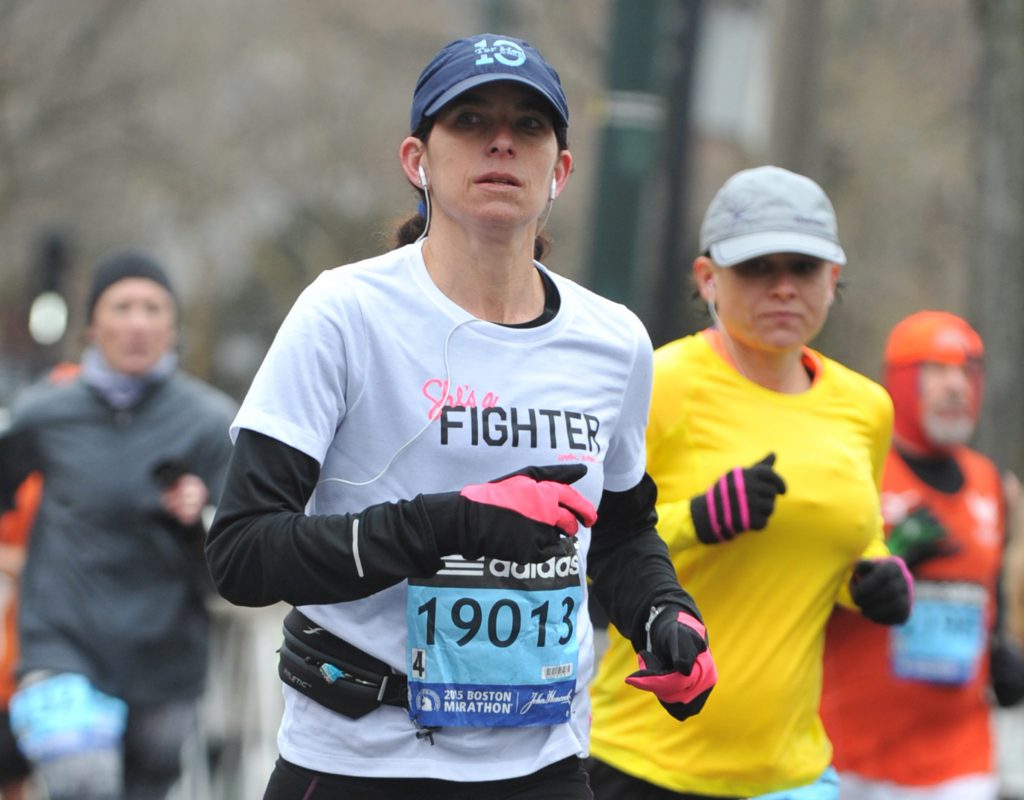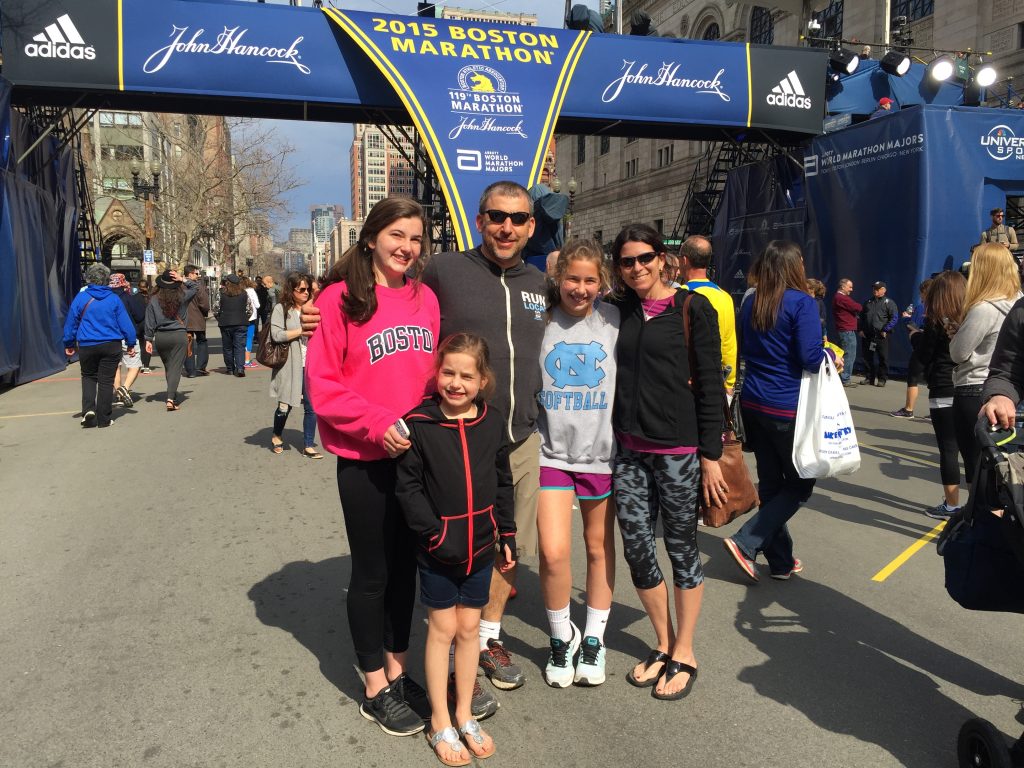Amy Charney had already registered to run the 2015 Boston Marathon when she was told she had breast cancer. But not even that diagnosis and active treatment would keep her from crossing the finish line in her hometown of Boston.


It was a cold, wet, windy day as Amy Charney looked out her bedroom window. She’d slept well, and even though it was raining, she was happy to be back in her hometown, running her seventh Boston Marathon. It had been almost six months since she’d been diagnosed with breast cancer, and she was still going through chemotherapy back home in Chapel Hill. But she was excited about the race, nervous to see if she could run the entire 26.2 miles. After Amy laced up her running shoes, she pinned the race bib onto her t-shirt, just below the words ‘She’s a FIGHTER!’
“Are you ready, Mom?” 13-year-old daughter Julia asked, grinning at her mother with pride.
Amy was more than ready; she was on a mission. And breast cancer wasn’t going to change her plans.
From Celebration to Sadness
Amy’s diagnosis came as a complete surprise back in November 2014, when her family was getting ready to celebrate her daughter’s Bat Mitzvah.
“We’d gone shopping for party dresses, and I was trying on some things in the fitting room,” says Amy. “And that’s when I saw it: a small, pea-sized lump on my breast. I made an appointment with my doctor, and since it was almost time for my annual visit, she suggested I have a diagnostic mammogram. That’s when I came to the NC Cancer Hospital.”
Amy’s mammogram results were negative, but because she has dense breasts, UNC breast radiologist Dr. Heidi Hartman recommended an ultrasound, which led to a biopsy. Amy was diagnosed with ductal carcinoma in situ, or DCIS, the most common type of non-invasive breast cancer. “After evaluating her options, Amy chose to have a lumpectomy and radiation,” explains Dr. Hartman. “However, her case was sent to our review board, and due to the density of her breasts, they wanted more information and asked Amy to have an MRI.”
Those results showed even more DCIS in the tissue, and after another biopsy, the board strongly suggested that Amy have a mastectomy. On January 13, 2015, David Ollila, MD, surgical director of the UNC Breast Center, performed a partial mastectomy and sentinel node biopsy. Fortunately, Amy’s lymph nodes were clear, but she did have a six millimeter stage 1 invasive breast cancer called ‘HER2-positive’. Her oncologist, Lisa Carey, MD, medical director of the UNC Breast Center, recommended chemotherapy for Amy.
“Years ago, this was worst, most aggressive type of cancer,” explains Dr. Carey. “But then studies began to show that the anti-HER2 drug Herceptin, combined with chemotherapy, really changed the game and made it a much more treatable cancer. But questions remain about the best way to administer these treatments.”
Dr. Carey explains that normally, patients are given high doses of several chemotherapy drugs with Herceptin added, followed by completion of a year of Herceptin. However, while this treatment protocol is very effective, the side effects can be tough on the patient. “So when Amy and I talked about her treatment options, I told her about a clinical trial initiated by colleagues at Dana Farber Cancer Institute. UNC is part of a group of academic institutions that work together on trials like this one,” says Dr. Carey. “In this study, we’re using a new drug called trastuzumab emtansine, known commercially as Kadcyla, which is a chemotherapy drug attached to Herceptin, so the chemotherapy only goes into the cancer instead of all over the body. It’s being called the ‘Trojan Horse’ because it’s such a targeted form of treatment. I was pleased that Amy agreed to be a clinical trial participant.”
Off and Running
Amy began the clinical trial drug combination, called TDM1, in February, but still, she kept on running. “I’d registered for the Boston Marathon back in September, 2014, and every time I went in for an appointment or a procedure, I’d ask the same question: ‘Will I be able to run my race?’ Thankfully, none of my caregivers ever told me no. But it was tough training. I wasn’t in the mood for it, so I just kept running as an emotional outlet, rather than for distance. I wanted to be Amy, the marathon runner, not Amy, the woman with cancer.”
So just six days after a chemotherapy treatment, Amy stood there at the starting line of the Boston Marathon while her husband Jonathan and daughters Julia, Elisabeth and Ava cheered her on. “I kept thinking, ‘You can’t finish if you don’t start.’ I just wanted to cross the finish line, not necessarily beat my own time. And before I knew it, we were off and running.”
The Boston Marathon is a grueling race with a course that winds through eight Massachusetts cities and towns. One of those is Brookline, the place where Amy grew up and where her mother, who died of lung cancer, was laid to rest. “Miles 22 through 24 of the Marathon run through my hometown,” explains Amy. “And during the race, that’s where something interesting happened. I don’t normally listen to music when I run, but this time, I needed it to help motivate me. When I passed the cemetery where my mom is buried, her favorite song began playing on my iPod. It’s by Blondie, and the words are, ‘The tide is high, but I’m holding on.’ It was a pretty emotional moment for a number of reasons.”
Amy crossed the finish line feeling exhausted, relieved, and most importantly, like a champion. “By running the Boston Marathon, I learned that, in spite of breast cancer, I am still me,” says Amy. “I still wear my running gear to every chemotherapy appointment to remind myself of who I am. I want this ordeal to be a thing of the past.”
Meanwhile, Dr. Carey says she’s happy with Amy’s response to the clinical trial drug and looks forward to seeing the final results of the study. “We’re finding that it’s as important to tailor a patient’s course of care to less treatment if possible, as it is to tailor care to more treatment if necessary,” says Dr. Carey. “It’s good to have options.”
Cancer a Marathon, Not a Sprint
While Amy continues her treatments at the NC Cancer Hospital, she’s also making the most of summer, taking picnics and trips to the pool with her family. Her job with Endurance Magazine in Durham also keeps her busy. “We produce the Tar Heel 10-Miler, a run that directly benefits UNC Lineberger Comprehensive Cancer Center. It’s ironic that my work has helped raise funds and awareness for cancer research, because now, UNC Lineberger’s cancer research is helping to save my life. I feel lucky to have UNC Lineberger almost literally in my back yard. I guess you could say my marathon has come full circle.”
